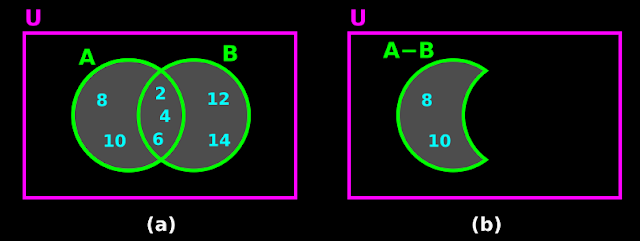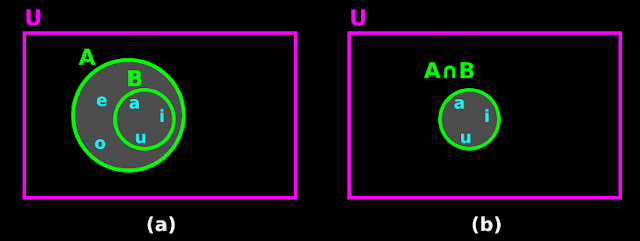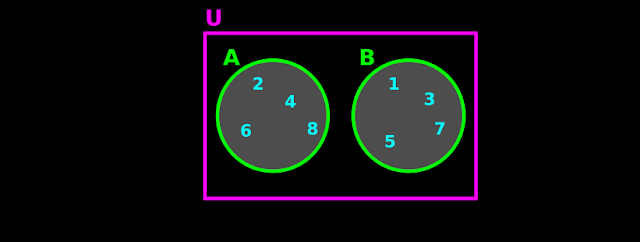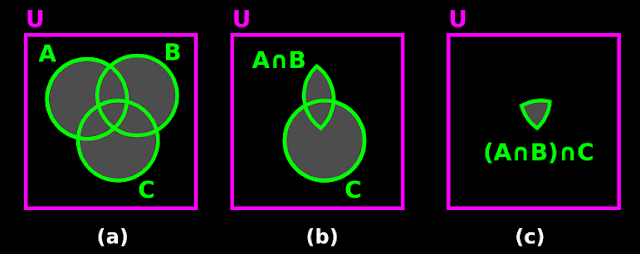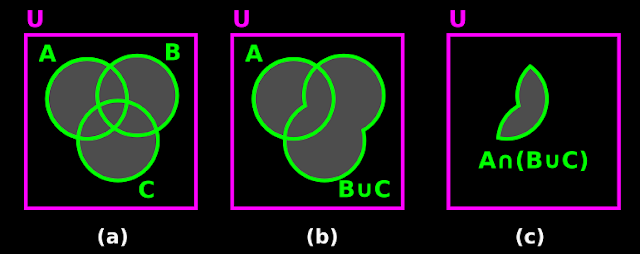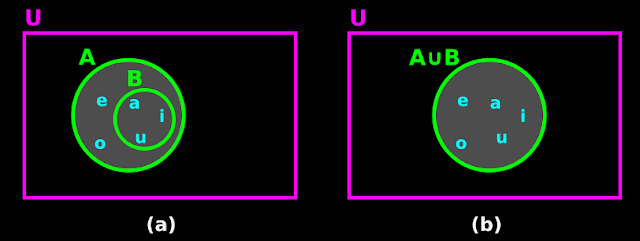In the previous section, we saw difference of sets. In this section, we will see complement of sets.
Complement of a set
• This can be explained in 9 steps:
1. Let U be a universal set which contains of all prime numbers.
• So U = {2, 3, 5, 7, 11, 13, . . .}
2. Let A be a set which contains all prime numbers which are not divisors of 42.
♦ Then A will be same as U, except for 2, 3 and 7
♦ This is because, 2, 3 and 7 are divisors of 42
✰ Prime numbers which are divisors of 42 are not allowed in A.
✰ Only the remaining prime numbers are allowed in A.
• So A = {5, 11, 13, . . .}
3. If we draw the Venn diagram, we will get fig.1.19(a) below:
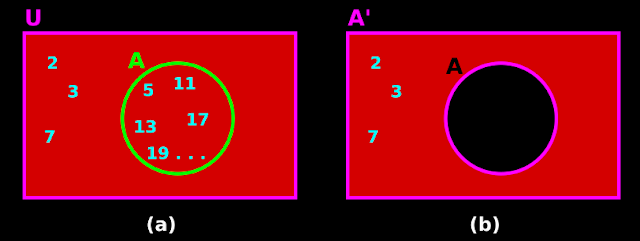 |
| Fig.1.19 |
• All elements except 2, 3 and 7 will lie inside the circle A.
• 2, 3 and 7 will lie outside the circle but inside the rectangle.
4. The set which contains those elements which lie outside the circle A, but inside the rectangle is called complement of A with respect to U.
♦ It is denoted by A’.
◼ So we can write: A’ = {2, 3, 7}
♦ Fig.b shows the Venn diagram of A’
• Note that, the portion of A is made hollow. This is because, we discard all elements of A.
5. It is clear that,
♦ All elements of A’ will be elements of U.
♦ Also, none of the elements of A’ will be an element of A.
6. We can write the definition:
| Definition 9: The complement set A’ is that set which contains all elements of U, which are not elements of A |
• Using symbols, we write: A’ = {x : x ∈ U and x ∉ A}
7. From the Venn diagram, it is clear that, A’ is obtained by removing A from U.
◼ So we can write: A’ = U-A
• In fig.1.19(b), the name of the rectangle is changed to A'. This is because, the rectangle no longer contains the elements of A. So it can no longer be called U. When A is removed, U becomes A'.
8. Let us see an example:
Let U = {1, 2, 3, 4, 5, 6, 7, 8, 9, 10} and A = {1, 3, 5, 7, 9}. Find A′.
Solution:
• We have: A' = U-A
• U - A can contain elements of U.
• U - A cannot contain any element of A.
♦ So we can right away discard set A.
• Also, U - A cannot contain any element which is common to both U and A.
♦ Thus we get: A' = U - A = {2, 4, 6, 8, 10}
9. Another example:
Let U = {x : x is a letter in the English alphabet} and A = {x : x is a vowel}. Find A'.
Solution:
• We have: A' = U-A
• U - A can contain elements of U.
• U - A cannot contain any element of A.
♦ So we can right away discard set A.
• Also, U - A cannot contain any element which is common to both U and A.
♦ So we remove all vowels from U.
♦ Thus we get: A' = U - A = {x : x is a consonant}.
10. Another example:
Let U = {x : x is a student in class XI} and A = {x : x is boy student in class XI}. Find A'.
Solution:
• We have: A' = U-A
• U - A can contain elements of U.
• U - A cannot contain any element of A.
♦ So we can right away discard set A.
• Also, U - A cannot contain any element which is common to both U and A.
♦ So we remove all boy students from U.
♦ Thus we get: A' = U - A = {x : x is a girl student in class XI}.
11. An interesting result can be derived in steps:
(i) Consider the example in (8). We derived the complement set A'.
(ii) Let us find the complement of this complement set.
• We have: (A')' = U - A'
(iii) That means, we have to remove all elements of A' from U.
• We get: (A')' = U - A' = {1, 3, 5, 7, 9}.
(iv) But {1, 3, 5, 7, 9} is A.
• So we can write: (A')' = A
12. Another example:
Let U = {1, 2, 3, 4, 5, 6}, A = {2, 3} and B = {3, 4, 5}.
Find A', B' , A' ∩ B', A ∪ B and hence show that (A ∪ B)' = A' ∩ B'.
solution:
(i) A' = U - A = {1, 4, 5, 6}
(ii) B' = U - B = {1, 2, 6}
(iii) A' ∩ B' = {1, 6}
(iv) A ∪ B = {2, 3, 4, 5}
(v) (A ∪ B)' = U - (A ∪ B) = {1,6}
(vi) From (iii) and (v), we see that: A' ∩ B' = (A ∪ B)'
13. The result in 12(vi) above, can be used as a general formula. It can be proved using Venn diagrams. We can write it in 7 steps:
(i) Fig.1.20(a) below shows A and B before union.
♦ Fig.1.20(b) shows A ∪ B.
♦ Fig.1.20(c) shows (A ∪ B)'.
 |
| Fig.1.20 |
(ii) Venn diagrams for individual complement sets:
• Fig.1.21(a) below shows A'.
♦ The set B is not present in A'. So it is drawn using a dotted curve.
♦ It's presence is imaginary.
♦ It is shown only to give an idea about the 'position of B' relative to A.
 |
| Fig.1.21 |
• Fig.1.21(b) shows B'
♦ The set A is not present in B'. So it is drawn using a dotted curve.
♦ It's presence is imaginary.
♦ It is shown only to give an idea about the
'position of A' relative to B.
(iii) Now we want the final fig. to show A' ∩ B'
• For that, we superimpose fig.1.21(a) over 1.21(b)
• Only 'that region' where both the following two regions fall, is eligible to be designated as A' ∩ B'.
♦ The red region from fig.a
♦ And the red region from fig.b
(Recall that, for intersection, elements from both the sets should be present)
(iv) In fig.a, the circle A does not have red shading. So that portion will not have red shading in A' ∩ B'.
(v) In fig.b, the circle B does not have red shading. So that portion will not have red shading in A' ∩ B'.
(vi) Thus when fig.a is superimposed on fig.b, the result will be as in fig.c
• We can write: Fig.1.21(c) shows A' ∩ B'.
(vii) Now compare fig.1.20(c) and fig.1.21(c)
♦ We see that, both are same.
◼ So we can write: (A ∪ B)' = A' ∩ B'
14. We can prove a similar result in 7 steps:
(i) Fig.1.22(a) below shows A and B before intersection.
♦ Fig.1.22(b) shows A ∩ B.
♦ Fig.1.22(c) shows (A ∩ B)'.
 |
| Fig,1.22 |
• Fig.1.23(a) below shows A'.
♦ The set B is not present in A'.
♦ So it is drawn using a dotted curve.It's presence is imaginary.
♦ It is shown only to give an idea about the position of B relative to A
 |
| Fig.1.23 |
♦ The set A is not present in B'.
♦ So it is drawn using a dotted curve. It's presence is imaginary.
♦ It is shown only to give an idea about the 'position of A' relative to B.
(iii) Now we want the final fig. to show A' ∪ B'.
• For that, we superimpose fig.1.23(a) over 1.23(b)
• 'That region' where any one of the following two regions fall, is eligible to be designated as A' ∪ B'.
♦ The red region from fig.a
♦ And the red region from fig.b
(Recall that, for union, elements from any one of the sets may be present)
(iv) In fig.a, the circle A does not have red shading. So it seems that, A will be absent in A' ∪ B'.
♦ But in the place of A, the dotted crescent is present in fig.b.
♦ It will compensate a major portion of A.
(v) In fig.b, the circle B does not have red shading. So it seems that, B will be absent in A' ∪ B'.
♦ But in the place of B, the dotted crescent is present in fig.a.
♦ It will compensate a major portion of B.
(vi) Thus when fig.a is superimposed on fig.b, the result will be as in fig.c
• We can write: Fig.1.23(c) shows A' ∪ B'.
(vii) Now compare fig.1.22(c) and fig.1.23(c)
♦ We see that, both are same.
◼ So we can write: (A ∩ B)' = A' ∪ B'
15. Let us write the two results together:
♦ From (13), we have: (A ∪ B)' = A' ∩ B'
♦ From (14), we have: (A ∩ B)' = A' ∪ B'
• The first result states that:
The complement of the union of two sets is the intersection of their complements
♦ That means,
✰ Complement of a union
✰ is equal to
✰ intersection of the individual complements
• The second result states that:
The complement of the intersection of two sets is the union of their complements.
♦ That means,
✰ Complement of a intersection
✰ is equal to
✰ union of the individual complements
◼ The two results are together called De Morgan’s laws.
Some Properties of Complement Sets
1. Complement laws:
(i) A ∪ A′ = U
• This is obvious from fig.1.19 that we saw at the beginning of this section.
• It is the union of two items:
♦ The set A' in fig.1.19(b).
♦ The set A in fig.1.19(a).
• The result will be U.
(ii) A ∩ A′ = ɸ
• This is obvious because, A' and A' will never have any common elements.
2. De Morgan’s law:
(i) (A ∪ B)' = A' ∩ B'
(ii) (A ∩ B)'′ = A' ∪ B'
• We have seen the proofs based on figs.1.20 to 1.23
3. Law of double complementation: (A')' = A
• We saw the proof in step (11) above.
4. Laws of empty set and universal set ɸ' = U and U' = ɸ
The link below gives some solved examples:
In the next
section, we will see some practical problems.
Previous
Contents
Next
Copyright©2021 Higher secondary physics.blogspot.com
